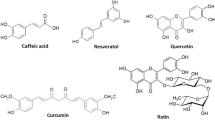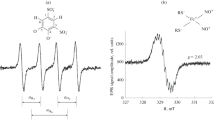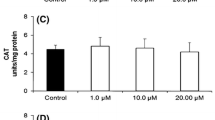Abstract
One of the current theories of cardiovascular disease is that it may begin with oxygen radical-induced damages. Extensive studies have been made in different laboratories to elucidate the mechanism of oxidative damages in the presence of added iron salts. However, thosein vitro studies are unlikely to be relevant to thein vivo situation, where in the normal physiological condition most of the iron remains bound with proteins. In the present study we have demonstrated that anin vitro system containing desferrioxamine, a strong iron chelator, superoxide generated by the action of xanthine oxidase on acetaldehyde initiates lipid peroxidation and protein changes in the guinea pig cardiac microsomes. We have further demonstrated that superoxide-initiated lipid peroxidation and protein changes are completely prevented by ascorbic acid. SOD also prevents but catalase, α-tocopherol, glutathione, uric acid, thiourea, mannitol and histidine are without effect. When NADPH is used instead of generated superoxide, the lipid peroxidation and protein changes are exclusively inhibited by ascorbic acid. SOD, catalase and other antioxidants are ineffective. The results obtained with guinea pigs may be extrapolated to humans, because like guinea pigs humans are also incapable of synthesizing ascorbic acid.
Similar content being viewed by others
References
Halliwell B, Gutteridge JMC: Role of free radicals and catalytic metal ions in human diseases: An overview. Methods Enzymol 186: 1–85, 1990
Davies KJA, Goldberg AL: Oxygen radicals stimulate intracellular proteolysis and lipid peroxidation by independent mechanisms in erythrocytes. J Biol Chem 262: 8220–8226, 1987
Fridovich I: Superoxide radical. An endogenous toxicant. Annu Rev Pharmacol Toxicol 23: 239–257, 1983
Aust SD, Roerig DL, Pederson TC: NADPH-dependent lipid peroxidation catalyzed by purified NADPH-cytochrome c reductase from rat liver microsomes. Biochem Biophys Res Commun 47: 1133–1137, 1972
Auclair C, Prost DD, Hakin J: Superoxide anion production by liver microsomes from phenobarbital treated rat. Biochem Pharmacol 27: 355–358, 1978
Kuthan H, Ullrich V, Eastbrook RW: A quantitative test for superoxide radicals produced in biological system. Biochem J 203: 551–558, 1982
Minakami H, Arai H, Nakano M, Sugioka K, Suzuki S, Sotomatsu A: A new and suitable reconstructed system for NADPH-dependent microsomal lipid peroxidation. Biochem Biophys Res Commun 153: 973–978, 1988
Som S, Raha C, Chatterjee IB: Ascorbic acid: a scavenger of superoxide radical. Acta Vitaminol Enzymol 5: 243–250, 1983
Nandi A, Chatterjee IB: Scavenging of superoxide radical by ascorbic acid. J Biosci 11: 435–441, 1987
Nandi A, Mukhopadhyay C, Chatterjee IB: Scavenging of superoxide radical by ascorbic acid and its role on dopamine β hydroxylase. Int J Toxicol Occup Environ Hlth 1: 43–48, 1991
Nishikimi M: Oxidation of ascorbic acid with superoxide anion generated by the xanthine-xanthine oxidase sytem. Biochem Biophys Res Commun 63: 463–468, 1975
Stadtman ER, Oliver CN: Metal catalyzed oxidation of proteins. Physiological consequences. J Biol Chem 266: 2205–2208, 1991
Chakraborty S, Nandi A, Mukhopadhyay CK, Chatterjee IB: Protective role of ascorbic acid against lipid peroxidation and myocarial injury. Mol Cell Biochem 111: 41–47, 1992
Singal PK, Kapur N, Dhillon KS, Beamish RE, Dhalla NS: Role of free radical in catecholamine-induced cardiomyopathy. Can J Physiol Pharmacol 60: 1390–1397, 1982
Kibata M, Higuchi Y: Serum α-tocopherol, coenzyme Q and thiobarbituric acid — reactive substance in acute myocardial damage and stroke. Ann NY Acad Sci 393: 179–182, 1982
Kudrin AN, Kogan AJ, Koroljiv UV, Nyikolajev SzM, Beszkrovnova NN: The role of lipid peroxidation in the pathogenesis of myocardial infarction and favourable effect of antioxidants sodium selenite and vitamin E. Kardiologia 18: 115, 1978
Das DK, Engelman RM: Mechanism of free radical generation during reperfusion of ischemic myocardium in oxygen radicals: Systemic events and disease processes. Das Esmann (eds) 1989, pp 97–127
McCord JM, Fridovich I: The reaction of cytochrome c by milk xanthine oxidase. J Biol Chem 243: 5753–5757, 1968
Battelli MG, DellaCorte E, Stirpe F: Xanthine oxidase type D (dehydrogenase) in the intestine and other organs of the rat. Biochem J 126: 747–749, 1972
Das DK, Engelman RM, Otani H, Rousou JA, Breyer RH, Lemeshow S: Effect of superoxide dismutase and catalase on myocardial energy metabolism during ischemia and reperfusion. Clin Physiol Biochem 4: 187–198, 1986
Martonosi A: Sarcoplasmic reticulum IV. Solubilization of microsomal adenosine triphosphate. J Biol Chem 243: 7181, 1968
Aikens J, Dix TA: Perhydroxyl radical initiated lipid peroxidation. J Biol Chem 266: 15091–15098, 1991
Esterbauer H, Cheeseman KH: Determination of aldehydic lipid peroxidation products: Malonaldehyde and 4-hydroxynonenal. Methods Enzymol 186: 407–421, 1990
Laemmli UK: Cleavage of structural proteins during the assembly of the head of bacteriophage Tr. Nature 227: 680–685, 1970
Miller DM, Spear NH, Aust SD: Effects of deferrioxamine on iron-catalyzed lipid peroxidation. Arch Biochem Biophys 295: 240–246, 1992
Thomas MJ, Mehl KS, Pryor WA: The role of superoxide in xanthine oxidase-induced autooxidation of linoleic acid. J Biol Chem 257: 8343–8347, 1982
Sutherland MW, Gebicki JM: A reaction between the superoxide free radical and lipid hydroperoxide in sodium linoleate micelles. Arch Biochem Biophys 214: 1–11, 1982
Peters JW, Foote CS: Chemistry of superoxide ion. II. Reaction with hydroperoxides. J Am Chem Soc 98: 873–875, 1976
Thomas MJ, Sutherland MW, Arudi RL, Bielski BHJ: Studies of the reactivity of\(HO_2 /O_2^{\bar \cdot } \) with unsaturated hydroperoxides in ethanolic solutions. Arch Biochem Biophys 233: 772–775, 1984
Gibian MJ, Ungermann T: The unlikelyhood of an electron-transfer (Haber-Weiss) reaction between superoxide and peroxides. J Am Chem Soc 101: 1291–1293, 1979
Stanley JP: Reactions of superoxide with peroxides. J Org Chem 45: 1413–1418, 1980
Davies KJA, Delsignore ME, Lin SW: Protein damage and degradation by oxygen radicals. Modification of amino acids. J Biol Chem 262: 9902–9907, 1987
Davies KJA, Delsignore ME: Protein damage and degradation by oxygen radicals. Modification of secondary and tertiary structure. J Biol Chem 262: 9908–9913, 1987
Davies KJA, Lin SW, Pacifici RE: Protein damage and degradation by oxygen radicals. Degradation of denatured protein. J Biol Chem 262: 9914–9920, 1987
Davies KJA, Goldberg AL: Proteins damaged by oxygen radicals are rapidly degraded in extracts of red blood cells. J Biol Chem 262: 8827–8834, 1987
Davies KJA: Protein damage and degradation by oxygen radicals. General aspects. J Biol Chem 262: 9895–9901, 1987
Wefers H, Sies H: The protection by ascorbate and glutathione against microsomal lipid peroxidation is dependent on vitamin E. Eur J Biochem 174: 353–357, 1988
Author information
Authors and Affiliations
Rights and permissions
About this article
Cite this article
Mukhopadhyay, M., Mukhopadhyay, C.K. & Chatterjee, I.B. Protective effect of ascorbic acid against lipid peroxidation and oxidative damage in cardiac microsomes. Mol Cell Biochem 126, 69–75 (1993). https://doi.org/10.1007/BF01772209
Issue Date:
DOI: https://doi.org/10.1007/BF01772209




